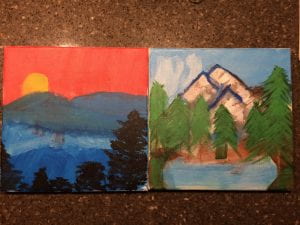For anyone that has forgotten, this is a quick refresher. I am doing acrylic painting. I chose acrylics because it seemed like an easier median of painting to pursue, than oils. One reason for that was because they dry quickly allowing you to paint over any mistakes you make. Another major reason is because acrylic paints are water based, allowing you to quickly clean up after you are done painting.
So far, I have finished three paintings and I am working on my fourth. Three of them were landscape paintings. I was pleasantly surprised by how well my first painting turned out. I layered everything properly and got the colours to be like what they were in the reference picture. But because it was my first time ever trying out acrylics, I did make a couple of mistakes.
The first mistake I made was choosing a picture that didn’t match the shape of my canvas. This meant I had to improvise a little bit and get creative with how I painted the picture. The second was that I didn’t cover the entire upper half of the canvas with paint before I started moving forward with the painting. This meant that I had to go back to finish filling in the sky after I had already started the mountains. Another mistake I made was with the transparency of the mountains. If you look at my first painting, you can see that the second row of mountains is too transparent and allows to much of the underlying canvas through. I plan to revisit this painting in a couple of weeks to see if I can do a better job of it.
The other two landscape paintings I did went okay, considering I didn’t use a reference picture. During the second painting, I tried using the pallet knife and found it to be far more difficult and frustrating then I first imagined. Therefore, I covered most of the middle section of the painting with trees. It helped to hide the poor job I did on the mountain. Because of how difficult I found the pallet knife to be, I chose to do my third painting only using the pallet knife. I thought this would be a great way to improve my skills and learn new techniques. By only using the pallet knife I did get more practice with it, but I didn’t learn any new techniques or tricks.
A frustration I have been having with the acrylics has to do with blending. Because acrylics dry so quickly, blending can be difficult. Blending is an important to for adding depth and perspective to a painting. That is why all my paintings thus far look flat. This will be one of the main challenges I will face throughout this project. The best technique I have found so far is using my finger to blend and soften the paint while it is still wet. Blending like this works best when the paint is still wet because it allows you to swirl and mix the colours together.
Pt. 2 How to have a Beautiful Mind
While I was reading through the book, I realized that these skills are very important. Because of how important they are, I decided to practice them with everybody, instead of just my mentor.
During my meeting with my mentor, I found agreeing to be the easiest skill for me to practice. I didn’t really disagree with anything he said because he has more experience than me.
While I was talking to him, I made sure to pay attention to the exercises he said helped him improve his painting. Mostly he recommended that I watch videos to see examples of good technique. I agreed with him, because I had already been watching videos before our meeting. It is because of these videos that I learned the finger blending technique I mentioned earlier.
One place I differed from my mentor was on a good first painting to do. I thought that landscape paintings were a good place to start, whereas my mentor believed I should start by making a colour wheel to practice my colour blending then move onto still life paintings. During our conversation about it I said, “I believe this difference may arise because of different personal preference and experience. My experience has been quite limited, and I prefer landscape paintings. You have far more experience with painting and have attended classes on painting where you are told to start with still life paintings.” After I said that, we changed the subject to something that we once again agreed on.
My mentor was great to practice with, but I also practiced with my friends during school and my free time. One of my best examples was while I was with some of my friends and one of them said “Is lava wet.”. (The question was silly, but it seemed like a good place to practice my skills) Then someone said, “What do you mean by wet?”. To add to the conversation, I said “Is water wet? Or are all liquids wet, because then, yes, lava would be wet. But another definition of wet could have to do with the moister of the object and not the form of the matter.” They said, “I believe water is wet and all liquids are wet, so lava is wet as well.” After that I said “I see where you are coming from, but I need to disagree. I believe that the moisture of something is directly related to how wet it is, instead of the form the matter takes.” And that is how we settled the question of how wet lava is.
Overall, these skills have been quite helpful to practice and progress. I plan to keep practicing them during the next few meetings with my mentor.


